Sensitivity and Directivity Analysis of Piezoelectric Ultrasonic Cantilever-Based MEMS Hydrophone for Underwater Applications
Abstract
1. Introduction
2. Materials and Methods
Device Design and Fabrication
3. Results and Discussion
3.1. Underwater Characterization
3.2. Directionality
4. Conclusions
Author Contributions
Funding
Conflicts of Interest
References
- Guan, L.; Xue, C.; Zhang, G.; Zhang, W.; Wang, P. Advancements in Technology and Design of NEMS Vector Hydrophone. Microsyst. Technol. 2011, 17, 459–467. [Google Scholar] [CrossRef]
- Chang, L. Foundations of MEMS, 2nd ed.; Gilfillan, A., Ed.; Pearson Education: London, UK, 2012; Chapter 3; p. 122. ISBN 0-13-249736-0. [Google Scholar]
- Yang, J.; Zhang, M.; Si, C.; Han, G.; Ning, J.; Yang, F.; Wang, X. A T-Shape Aluminum Nitride Thin-Film Piezoelectric MEMS Resonant Accelerometer. J. Microelectromech. Syst. 2019, 28, 776–781. [Google Scholar] [CrossRef]
- Wang, Y.; Yan, J.; Cheng, H.; Chen, N.; Yan, P.; Ouyang, J. Low Thermal Budget Lead Zirconate Titanate Thick Films Integrated on Si for Piezo-MEMS Applications. Microelectron. Eng. 2020, 219, 111145. [Google Scholar] [CrossRef]
- Guojun, Z.; Panpan, W.; Linggang, G.; Jijun, X.; Wendong, Z. Improvement of the MEMS Bionic Vector Hydrophone. Microelectron. J. 2011, 42, 815–819. [Google Scholar] [CrossRef]
- Xue, C.; Chen, S.; Zhang, W.; Zhang, B.; Zhang, G.; Qiao, H. Design, Fabrication, and Preliminary Characterization of a Novel MEMS Bionic Vector Hydrophone. Microelectron. J. 2007, 38, 1021–1026. [Google Scholar] [CrossRef]
- Rockstad, H.K.; Kenny, T.W.; Kelly, P.J.; Gabrielson, T.B. A Microfabricated Electron-Tunneling Accelerometer as a Directional Underwater Acoustic Sensor. Am. Inst. Phys. 2008, 57, 57–68. [Google Scholar] [CrossRef]
- Swartz, R.G.; Plummer, J.D. Integrated Silicon-PVF2 Acoustic Transducer Arrays. IEEE Trans. Electron. Devices 1979, 26, 1921–1931. [Google Scholar] [CrossRef]
- Akasheh, F.; Myers, T.; Fraser, J.D.; Bose, S.; Bandyopadhyay, A. Development of Piezoelectric Micromachined Ultrasonic Transducers. Sens. Actuators A Phys. 2004, 111, 275–287. [Google Scholar] [CrossRef]
- Guan, L.; Zhang, G.; Xu, J.; Xue, C.; Zhang, W.; Xiong, J. Design of T-Shape Vector Hydrophone Based on MEMS. Sens. Actuators A Phys. 2012, 188, 35–40. [Google Scholar] [CrossRef]
- Minh-Dung, N.; Hoang-Phuong, P.; Matsumoto, K.; Shimoyama, L. A Sensitive Liquid-Cantilever Diaphragm for Pressure Sensor. In Proceedings of the 2013 IEEE 26th International Conference on Micro Electro Mechanical Systems (MEMS), Taipei, Taiwan, 20–24 January 2013; pp. 617–620. [Google Scholar] [CrossRef]
- Minh-Dimg, N.; Hoang-Phuong, P.; Matsumoto, K.; Shimoyama, I. A Hydrophone Using Liquid to Bridge the Gap of a Piezo-Resistive Cantilever. In Proceedings of the 17th International Conference on Solid-State Sensors, Actuators and Microsystems (Transducers & Eurosensors XXVII, Barcelona, Spain, 16–20 June 2013; pp. 70–73. [Google Scholar] [CrossRef]
- Choi, S.; Lee, H.; Moon, W. A Micro-Machined Piezoelectric Hydrophone with Hydrostatically Balanced Air Backing. Sens. Actuators A Phys. 2010, 158, 60–71. [Google Scholar] [CrossRef]
- Tan, X.; Lv, Y.; Zhou, X.; Song, X.; Wang, Y.; Gu, G.; Guo, H.; Liang, S.; Feng, Z.; Cai, S. High Performance AlGaN/GaN Pressure Sensor with a Wheatstone Bridge Circuit. Microelectron. Eng. 2020, 219, 111143. [Google Scholar] [CrossRef]
- Amiri, P.; Kordrostami, Z. Sensitivity Enhancement of MEMS Diaphragm Hydrophones Using an Integrated Ring MOSFET Transducer. IEEE Trans. Ultrason. Ferroelectr. Freq. Control 2018, 65, 2121–2130. [Google Scholar] [CrossRef] [PubMed]
- Kordrostami, Z.; Roohizadegan, S. Particle Swarm Approach to the Optimisation of Trenched Cantilever-Based MEMS Piezoelectric Energy Harvesters. IET Sci. Meas. Technol. 2019, 13, 536–543. [Google Scholar] [CrossRef]
- Malleron, K.; Gensbittel, A.; Talleb, H.; Ren, Z. Experimental Study of Magnetoelectric Transducers for Power Supply of Small Biomedical Devices. Microelectron. J. 2019, 88, 184–189. [Google Scholar] [CrossRef]
- Kashiwao, T.; Izadgoshasb, I.; Lim, Y.Y.; Deguchi, M. Optimization of Rectifier Circuits for a Vibration Energy Harvesting System Using a Macro-Fiber Composite Piezoelectric Element. Microelectron. J. 2016, 54, 109–115. [Google Scholar] [CrossRef]
- Littrell, R.; Grosh, K. Modeling and Characterization of Cantilever-Based MEMS Piezoelectric Sensors and Actuators. J. Microelectromech. Syst. 2012, 21, 406–413. [Google Scholar] [CrossRef]
- Tsai, J.M.; Daneman, M.; Boser, B.; Horsley, D.; Tang, H.Y.; Lu, Y.; Rozen, O.; Liu, F.; Lim, M.; Assaderaghi, F. Versatile CMOS-MEMS Integrated Piezoelectric Platform. In Proceedings of the 18th International Conference on Solid-State Sensors, Actuators and Microsystems (Transducers), Alaska, AK, USA, 21–25 June 2015; pp. 2248–2251. [Google Scholar] [CrossRef]
- Horsley, D.A.; Przybyla, R.J.; Kline, M.H.; Shelton, S.E.; Guedes, A.; Izyumin, O.; Boser, B.E. Piezoelectric Micro Machined Ultrasonic Transducers in Consumer Electronics: The Next Little Things? In Proceedings of the 2016 IEEE 29th International Conference on Micro Electro Mechanical Systems (MEMS), Shanghai, China, 24–28 January 2016; pp. 145–148. [Google Scholar] [CrossRef]
- Xu, J.; Zhang, X.; Fernando, S.N.; Chai, K.T.; Gu, Y. AlN-on-SOI Platform-Based Micro-Machined Hydrophone. Appl. Phys. Lett. 2016, 109, 3–8. [Google Scholar] [CrossRef]
- Roozbeh, T.; Mojtaba, H.S.; Farrokh, A. High-Frequency AlN-on-Silicon Resonant Square Gyroscopes. J. Microelectromech. Syst. 2011, 20, 1225–1227. [Google Scholar] [CrossRef]
- Hodjat-Shamami, M.; Norouzpour-Shirazi, A.; Tabrizian, R.; Ayazi, F. A Dynamically Mode-Matched Piezoelectrically Transduced High-Frequency Flexural Disk Gyroscope. In Proceedings of the 2015 28th IEEE International Conference on Micro Electro Mechanical Systems (MEMS), Estoril, Portugal, 18–22 January 2015; pp. 789–792. [Google Scholar] [CrossRef]
- Goericke, F.T.; Vigevani, G.; Pisano, A.P. Bent-Beam Sensing with Triple-Beam Tuning Forks. Appl. Phys. Lett. 2013, 102. [Google Scholar] [CrossRef]
- Zuo, C.; Van Der Spiegel, J.; Piazza, G. 1.05-GHz CMOS Oscillator Based on Lateral- Field-Excited Piezoelectric AlN Contour-Mode MEMS Resonators. IEEE Trans. Ultrason. Ferroelectr. Freq. Control 2010, 57, 82–87. [Google Scholar] [CrossRef]
- Sorokin, B.P.; Kvashnin, G.M.; Volkov, A.P.; Bormashov, V.S.; Aksenenkov, V.V.; Kuznetsov, M.S.; Gordeev, G.I.; Telichko, A.V. AlN/Single Crystalline Diamond Piezoelectric Structure as a High Overtone Bulk Acoustic Resonator. Appl. Phys. Lett. 2013, 102, 10–13. [Google Scholar] [CrossRef]
- Lin, C.M.; Yen, T.T.; Lai, Y.J.; Felmetsger, V.V.; Hopcroft, M.A.; Kuypers, J.H.; Pisano, A.P. Temperature-Compensated Aluminum Nitride Lamb Wave Resonators. IEEE Trans. Ultrason. Ferroelectr. Freq. Control 2010, 57, 524–532. [Google Scholar] [CrossRef] [PubMed]
- Iqbal, A.; Mohd-Yasin, F. Reactive Sputtering of Aluminum Nitride (002) Thin Films for Piezoelectric Applications: A Review. Sensors 2018, 18, 1797. [Google Scholar] [CrossRef] [PubMed]
- Liang, J.; Zhang, H.; Zhang, D.; Duan, X.; Zhang, H.; Pang, W. Design and Fabrication of Aluminum Nitride Lamb Wave Resonators towards High Figure of Merit for Intermediate Frequency Filter Applications. J. Micromech. Microeng. 2015, 25. [Google Scholar] [CrossRef]
- Kordrostami, Z.; Roohizadegan, S. A Groove Engineered Ultralow Frequency Piezomems Energy Harvester with Ultrahigh Output Voltage. Int. J. Mod. Phys. B 2018, 32, 1–17. [Google Scholar] [CrossRef]
- Ghoddus, H.; Kordrostami, Z. Harvesting the Ultimate Electrical Power from MEMS Piezoelectric Vibration Energy Harvesters: An Optimization Approach. IEEE Sens. J. 2018, 18, 8667–8675. [Google Scholar] [CrossRef]
- Ghoddus, H.; Kordrostami, Z.; Amiri, P. Performance Enhancement of MEMS-Guided Four Beam Piezoelectric Transducers for Energy Harvesting and Acceleration Sensing. Int. J. Mod. Phys. B 2019, 33, 1–16. [Google Scholar] [CrossRef]
- Asthana, P.; Khanna, G. A Broadband Piezoelectric Energy Harvester for IoT Based Applications. Microelectron. J. 2019, 93, 104635. [Google Scholar] [CrossRef]
- Abdelmageed, M.G.; Fath El-Bab, A.M.R.; Abouelsoud, A.A. Design and Simulation of Pulsatile Blood Flow Energy Harvester for Powering Medical Devices. Microelectron. J. 2019, 8, 105–113. [Google Scholar] [CrossRef]
- Sherman, C.H.; Bulter, J.L. Transducers and Arrays for Underwater Sound, 1st ed.; Springer: New York, NY, USA, 2007. [Google Scholar] [CrossRef]
- Asadnia, M.; Kottapalli, A.G.P.; Shen, Z.; Miao, J.; Triantafyllou, M. Flexible and Surface-Mountable Piezoelectric Sensor Arrays for Underwater Sensing in Marine Vehicles. IEEE Sens. J. 2013, 13, 3918–3925. [Google Scholar] [CrossRef]
- Lasky, M.; Doolittle, R.D.; Simmons, B.D.; Lemon, S.G. Recent Progress in Towed Hydrophone Array Research. IEEE J. Ocean. Eng. 2004, 29, 374–387. [Google Scholar] [CrossRef]
- Bernstein, J.J.; Finberg, S.L.; Houston, K.; Niles, L.C.; Daniel Chen, H.; Eric Cross, L.; Li, K.K.; Udayakumar, K. Micromachined High Frequency Ferroelectric Sonar Transducers. IEEE Trans. Ultrason. Ferroelectr. Freq. Control 1997, 44, 960–969. [Google Scholar] [CrossRef]
- Asanuma, H.; Hashimoto, S.; Tano, S.I.; Takashima, S.I.; Nishizawa, M.; Niitsuma, H.; Shindo, Y. Development of Fiber-Optical Microsensors for Geophysical Use. In Proceedings of the 2003 International Conference on Physics and Control, Tokyo, Japan, 25–27 June 2003; p. 315. [Google Scholar] [CrossRef]
- Huttunen, T.; Kaipio, J.P.; Hynynen, K. Modeling of Anomalies Due to Hydrophones in Continuous-Wave Ultrasound Fields. IEEE Trans. Ultrason. Ferroelectr. Freq. Control. 2003, 50, 1486–1500. [Google Scholar] [CrossRef] [PubMed]
- Rizzi, F.; Qualtieri, A.; Dattoma, T.; Epifani, G.; De Vittorio, M. Biomimetics of Underwater Hair Cell Sensing. Microelectron. Eng. 2015, 132, 90–97. [Google Scholar] [CrossRef]
- Abels, C.; Mastronardi, V.M.; Guido, F.; Dattoma, T.; Qualtieri, A.; Megill, W.M.; De Vittorio, M.; Rizzi, F. Nitride-Based Materials for Flexible MEMS Tactile and Flow Sensors in Robotics. Sensors 2017, 17, 1080. [Google Scholar] [CrossRef] [PubMed]
- Abdul, B.; Mastronardi, V.M.; Qualtieri, A.; Guido, F.; Algieri, L.; Rizzi, F.; De Vittorio, M. Design, Fabrication and Characterization of Piezoelectric Cantilever MEMS for Underwater Application. Micro Nano Eng. 2020, 7, 100050. [Google Scholar] [CrossRef]
- Rizzi, F.; Qualtieri, A.; Chambers, L.; Epifani, G.; Megil, M.W.; De Vittorio, M. Stress-Driven Artificial Hair Cell for Flow Sensing. In Flow Sensing in Air and Water; Bleckmann, H., Mogdans, J., Coombs, S.L., Eds.; Springer: Berlin/Heidelberg, Germany, 2014; Chapter 9; pp. 499–520. [Google Scholar] [CrossRef]
- Qualtieri, A.; Rizzi, F.; Todaro, M.T.; Passaseo, A.; Cingolani, R.; De Vittorio, M. Stress-Driven AlN Cantilever-Based Flow Sensor for Fish Lateral Line System. Microelectron. Eng. 2011, 88, 2376–2378. [Google Scholar] [CrossRef]
- Qualtieri, A.; Rizzi, F.; Epifani, G.; Ernits, A.; Kruusmaa, M.; De Vittorio, M. Parylene-Coated Bioinspired Artificial Hair Cell for Liquid Flow Sensing. Microelectron. Eng. 2012, 98, 516–519. [Google Scholar] [CrossRef]
- Lim, Y.; Joh, C.; Seo, H.; Kim, J.; Roh, Y. Design and Fabrication of a Multimode Ring Vector Hydrophone. Jpn. J. Appl. Phys. 2014, 53. [Google Scholar] [CrossRef]
- Butler, A.L.; Butler, J.L.; Dalton, W.L.; Rice, J.A. Multimode Directional Telesonar Transducer. Ocean. Conf. Rec. 2000, 2, 1289–1292. [Google Scholar] [CrossRef]
- Sessler, G.M.; West, J.E. Directional Transducers. IEEE Trans. Audio Electroacoust. 1971, 19, 19–23. [Google Scholar] [CrossRef]
- Caruso, F.; Alonge, G.; Bellia, G.; De Domenico, E.; Grammauta, R.; Larosa, G.; Mazzola, S.; Riccobene, G.; Pavan, G.; Papale, E.; et al. Long-Term Monitoring of Dolphin Biosonar Activity in Deep Pelagic Waters of the Mediterranean Sea. Sci. Rep. 2017, 7, 1–12. [Google Scholar] [CrossRef] [PubMed]
- Madaro, F.; Mehdipour, I.; Caricato, A.; Guido, F.; Rizzi, F.; Carlucci, A.P.; De Vittorio, M. Available Energy in Cars’ Exhaust System for IoT Remote Exhaust Gas Sensor and Piezoelectric Harvesting. Energies 2020, 13, 4169. [Google Scholar] [CrossRef]
- COMSOL. Material Database; COMSOL: Burlington, MA, USA, 2020. [Google Scholar]
- Bao, M.H. Analysis and Design Principles of MEMS Devices, 1st ed.; Elsevier: Amsterdam, The Netherlands, 2005; Chapter 2; pp. 71–72. [Google Scholar] [CrossRef]
- Hang, G.J.; Li, Z.; Wu, S.J.; Xue, C.Y.; Yang, S.E.; Zhang, W.D. A Bionic Fish Cilia Median-Low Frequency Three-Dimensional Piezoresistive MEMS Vector Hydrophone. Nano-Micro Lett. 2014, 6, 136–142. [Google Scholar] [CrossRef]
- Onda Hydrophone Corporation. Available online: http://www.generex.co.jp/Ultrasonic/Hydrophone/pdf/2013_ONDA_HNP_120913.pdf (accessed on 20 June 2020).
- Brüel & Kjær. Technical Documentation: Hydrophones—Types 8103, 8104, 8105 and 8106; Brüel & Kjær: Nærum, Denmark, 1992; p. 8. Available online: http://www.lthe.fr/LTHE/IMG/pdf/DocBruelKjaerHydro.pdf (accessed on 8 October 2020).
- Liu, L.; Zhang, W.; Zhang, G.; Guan, L.; Xue, C.; Zhang, H.; Xue, N. Research on Double T-Shape MEMS Bionic Vector Hydrophone and Its Application in Obstacle Avoidance Sonar. Sens. Rev. 2015, 35, 76–84. [Google Scholar] [CrossRef]
- Guan, L.; Zhang, G.; Xue, C.; Zhang, W.; Xiong, J.; Xu, J. Design of T-shape vector hydrophone based on MEMS. In Proceedings of the 2011 16th International Solid-State Sensors, Actuators and Microsystems Conference, Beijing, China, 5–9 June 2011; pp. 20–23. [Google Scholar]
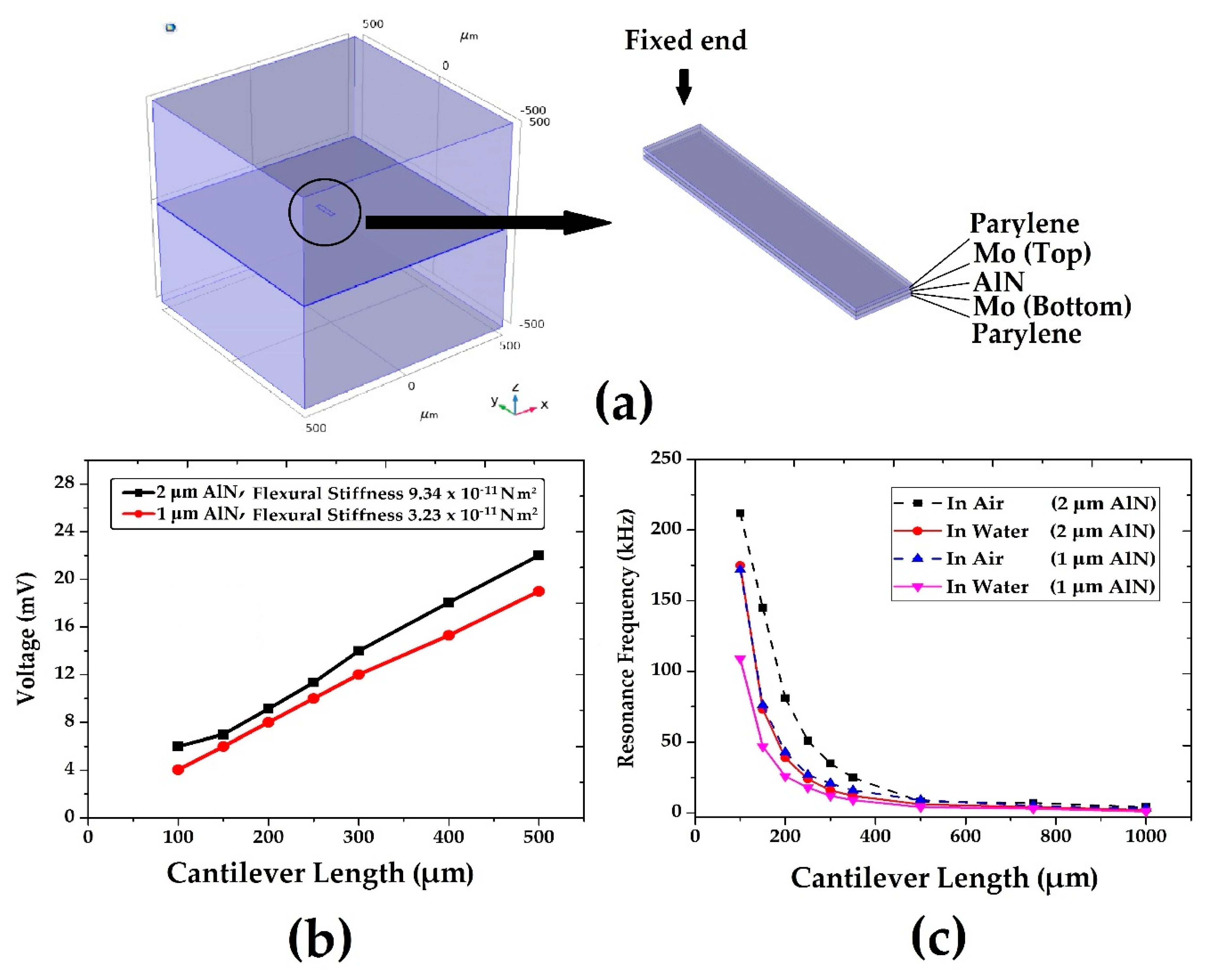
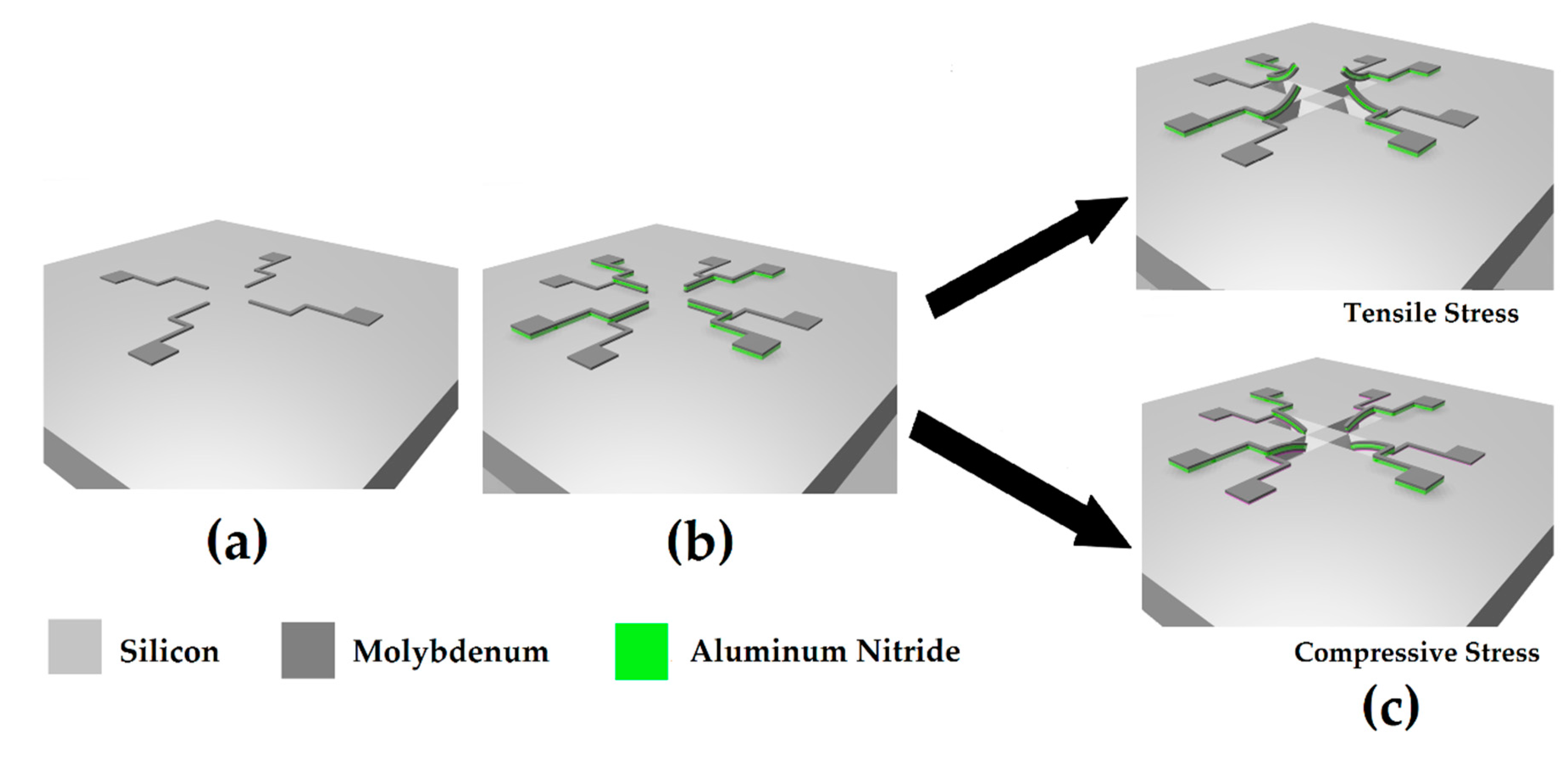

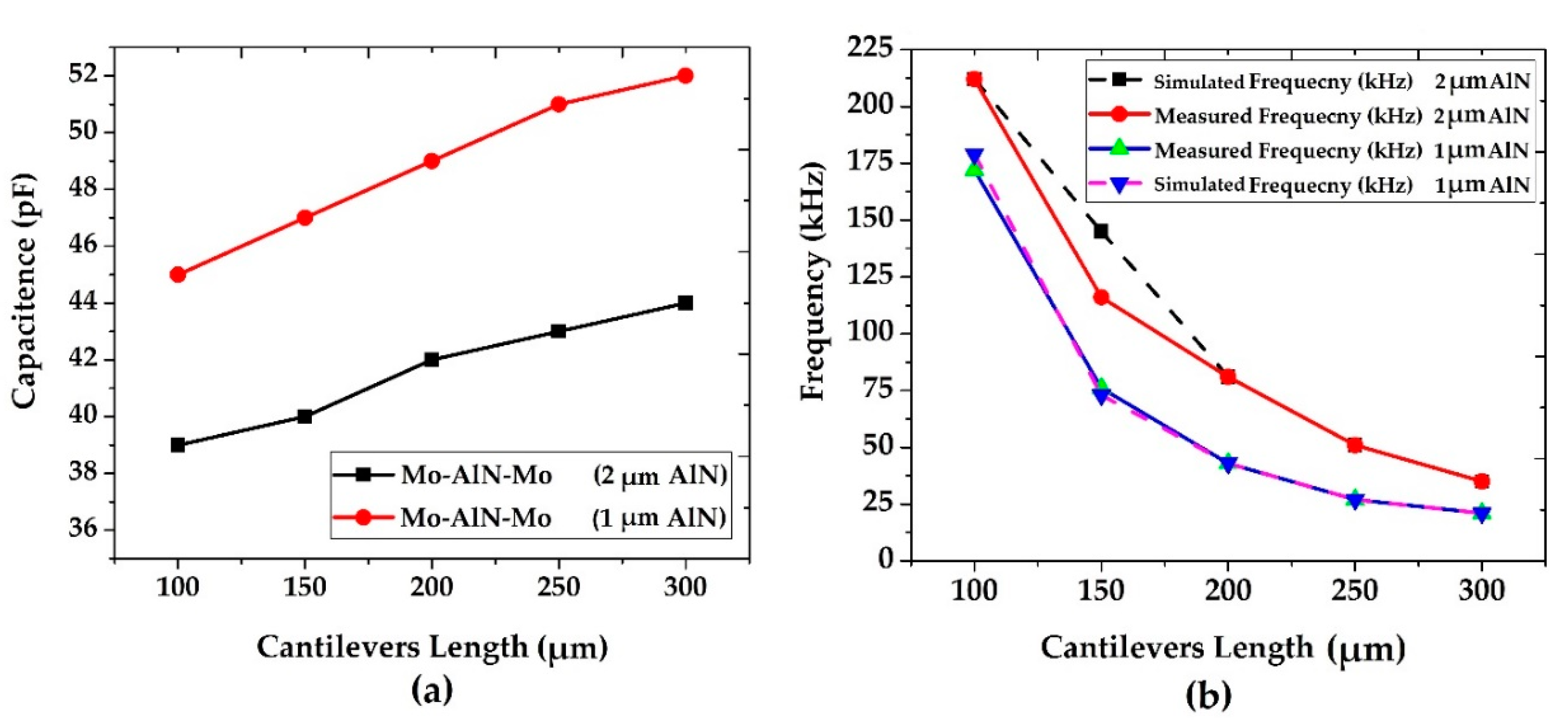
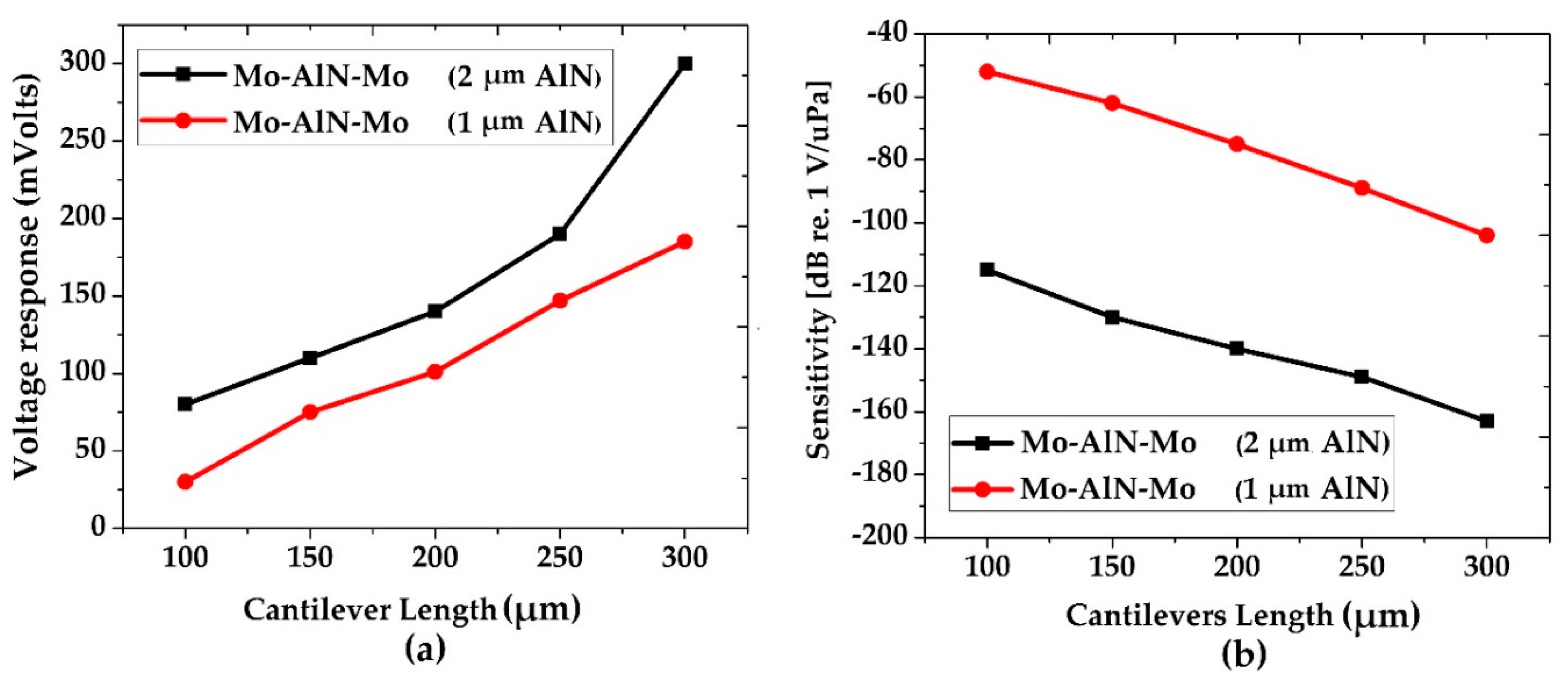

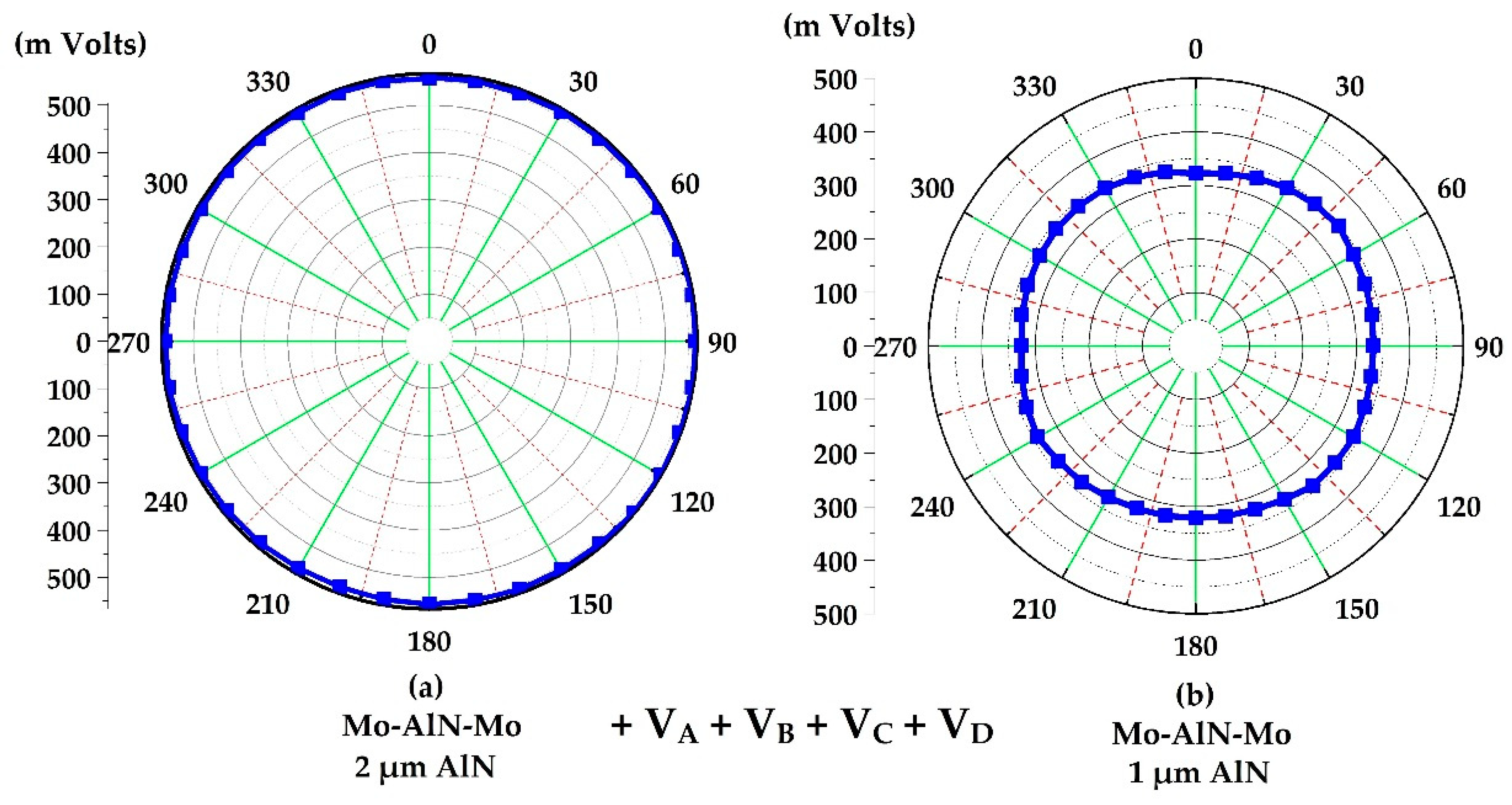

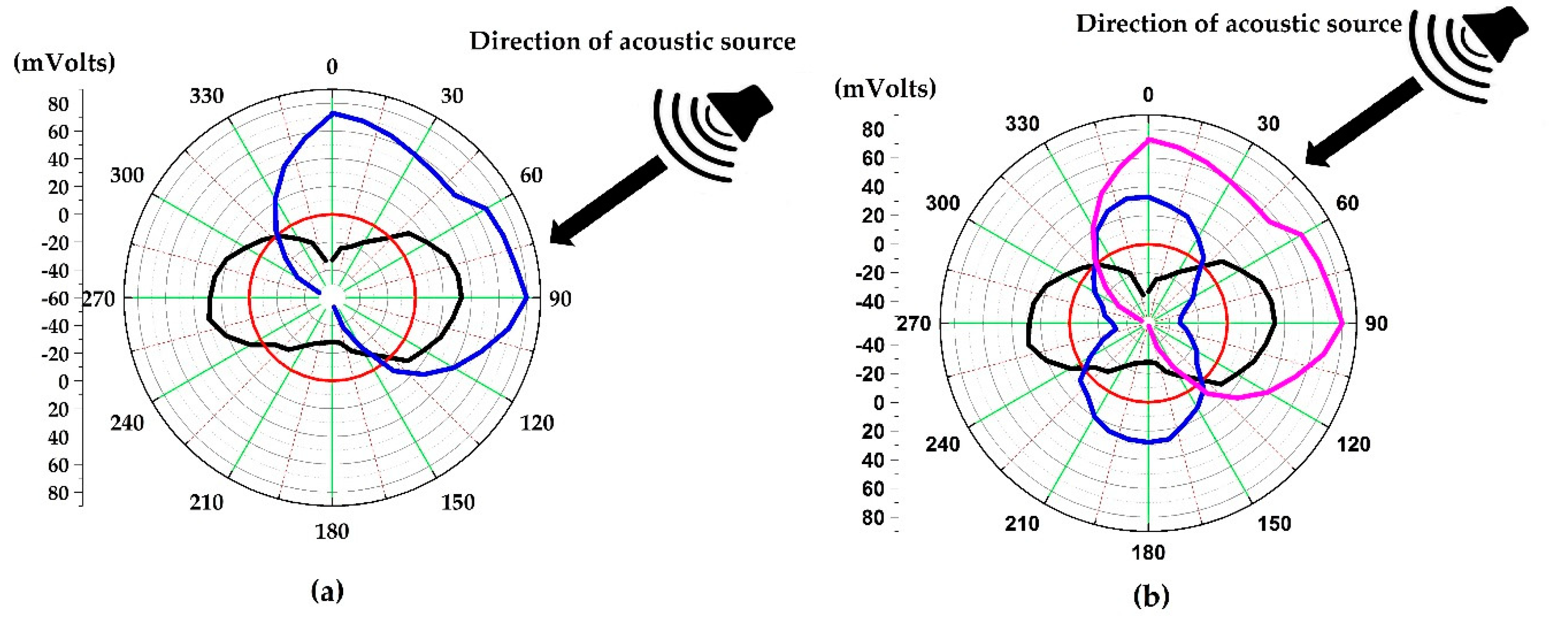
| Material | Thickness | Poisson Ratio | Density (g/cm3) | Young Modulus (GPa) | Relative Permittivity |
|---|---|---|---|---|---|
| Molybdenum | 200 nm (Top and Bottom) | 0.29 | 10.1 | 315 | 1 |
| Aluminum Nitride Parylene | 1 µm and 2 µm 1 µm | 0.27 0.40 | 3.30 1.28 | 348 2.80 | 9 - |
| Reference | Cantilevers (L X W X T) µm | Sensitivity (dB) | Frequency Band Width | Transduction Mechanisms |
|---|---|---|---|---|
| [57] [3] [58] [59] [55] [1] [6] | - 1000 × 120 × 10 1500 × 130 × 20 3500 × 130 × 20 - 1000 × 120 × 15 5000 × 150 | −211 −197 −180 −180 −180 −170 −165 | 20 kHz to 180 kHz @ 40 Hz 20Hz to 2 kHz 20 Hz to 2.5 kHz 25 Hz to 1.5 kHz 40 Hz to 4 kHz 20 Hz to 2 kHz | Commercial, Needle-Based Piezo-resistive Piezo-resistive Piezo-resistive Piezo-resistive Piezo-resistive Piezo-resistive |
| MEMS Hydrophone (In this paper) | 300 × 70 × 2.4 | −163 | 20 kHz to 200 kHz | Piezo-electric |
© 2020 by the authors. Licensee MDPI, Basel, Switzerland. This article is an open access article distributed under the terms and conditions of the Creative Commons Attribution (CC BY) license (http://creativecommons.org/licenses/by/4.0/).
Share and Cite
Abdul, B.; Mastronardi, V.M.; Qualtieri, A.; Algieri, L.; Guido, F.; Rizzi, F.; De Vittorio, M. Sensitivity and Directivity Analysis of Piezoelectric Ultrasonic Cantilever-Based MEMS Hydrophone for Underwater Applications. J. Mar. Sci. Eng. 2020, 8, 784. https://doi.org/10.3390/jmse8100784
Abdul B, Mastronardi VM, Qualtieri A, Algieri L, Guido F, Rizzi F, De Vittorio M. Sensitivity and Directivity Analysis of Piezoelectric Ultrasonic Cantilever-Based MEMS Hydrophone for Underwater Applications. Journal of Marine Science and Engineering. 2020; 8(10):784. https://doi.org/10.3390/jmse8100784
Chicago/Turabian StyleAbdul, Basit, Vincenzo Mariano Mastronardi, Antonio Qualtieri, Luciana Algieri, Francesco Guido, Francesco Rizzi, and Massimo De Vittorio. 2020. "Sensitivity and Directivity Analysis of Piezoelectric Ultrasonic Cantilever-Based MEMS Hydrophone for Underwater Applications" Journal of Marine Science and Engineering 8, no. 10: 784. https://doi.org/10.3390/jmse8100784
APA StyleAbdul, B., Mastronardi, V. M., Qualtieri, A., Algieri, L., Guido, F., Rizzi, F., & De Vittorio, M. (2020). Sensitivity and Directivity Analysis of Piezoelectric Ultrasonic Cantilever-Based MEMS Hydrophone for Underwater Applications. Journal of Marine Science and Engineering, 8(10), 784. https://doi.org/10.3390/jmse8100784





